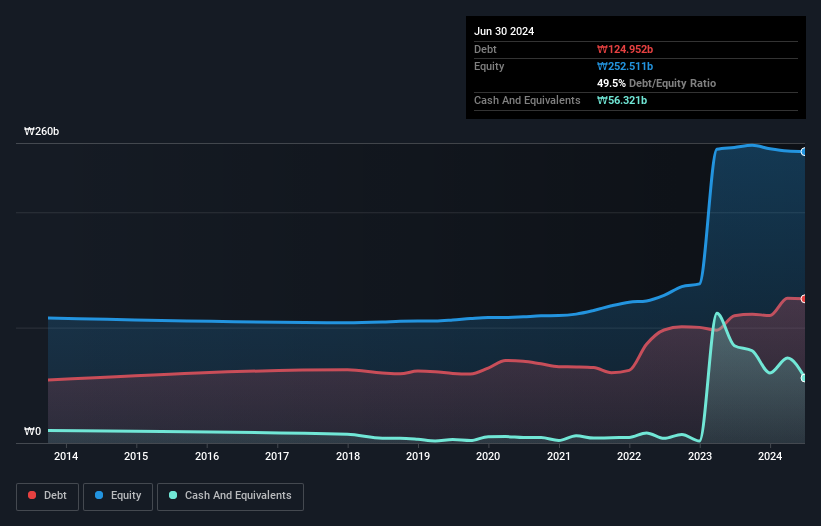- South Korea
- /
- Metals and Mining
- /
- KOSE:A006110
Does Sam-A Aluminium Company (KRX:006110) Have A Healthy Balance Sheet?
Warren Buffett famously said, 'Volatility is far from synonymous with risk.' So it seems the smart money knows that debt - which is usually involved in bankruptcies - is a very important factor, when you assess how risky a company is. We can see that Sam-A Aluminium Company, Limited (KRX:006110) does use debt in its business. But is this debt a concern to shareholders?
When Is Debt A Problem?
Debt assists a business until the business has trouble paying it off, either with new capital or with free cash flow. If things get really bad, the lenders can take control of the business. However, a more usual (but still expensive) situation is where a company must dilute shareholders at a cheap share price simply to get debt under control. Of course, debt can be an important tool in businesses, particularly capital heavy businesses. When we examine debt levels, we first consider both cash and debt levels, together.
Check out our latest analysis for Sam-A Aluminium Company
How Much Debt Does Sam-A Aluminium Company Carry?
As you can see below, at the end of June 2024, Sam-A Aluminium Company had ₩125.0b of debt, up from ₩110.3b a year ago. Click the image for more detail. On the flip side, it has ₩56.3b in cash leading to net debt of about ₩68.6b.

A Look At Sam-A Aluminium Company's Liabilities
The latest balance sheet data shows that Sam-A Aluminium Company had liabilities of ₩93.6b due within a year, and liabilities of ₩70.0b falling due after that. On the other hand, it had cash of ₩56.3b and ₩41.6b worth of receivables due within a year. So its liabilities total ₩65.7b more than the combination of its cash and short-term receivables.
Of course, Sam-A Aluminium Company has a market capitalization of ₩628.2b, so these liabilities are probably manageable. However, we do think it is worth keeping an eye on its balance sheet strength, as it may change over time. The balance sheet is clearly the area to focus on when you are analysing debt. But it is Sam-A Aluminium Company's earnings that will influence how the balance sheet holds up in the future. So when considering debt, it's definitely worth looking at the earnings trend. Click here for an interactive snapshot.
Over 12 months, Sam-A Aluminium Company made a loss at the EBIT level, and saw its revenue drop to ₩262b, which is a fall of 11%. That's not what we would hope to see.
Caveat Emptor
Not only did Sam-A Aluminium Company's revenue slip over the last twelve months, but it also produced negative earnings before interest and tax (EBIT). To be specific the EBIT loss came in at ₩1.2b. When we look at that and recall the liabilities on its balance sheet, relative to cash, it seems unwise to us for the company to have any debt. Quite frankly we think the balance sheet is far from match-fit, although it could be improved with time. However, it doesn't help that it burned through ₩39b of cash over the last year. So in short it's a really risky stock. The balance sheet is clearly the area to focus on when you are analysing debt. But ultimately, every company can contain risks that exist outside of the balance sheet. For example, we've discovered 2 warning signs for Sam-A Aluminium Company that you should be aware of before investing here.
At the end of the day, it's often better to focus on companies that are free from net debt. You can access our special list of such companies (all with a track record of profit growth). It's free.
New: Manage All Your Stock Portfolios in One Place
We've created the ultimate portfolio companion for stock investors, and it's free.
• Connect an unlimited number of Portfolios and see your total in one currency
• Be alerted to new Warning Signs or Risks via email or mobile
• Track the Fair Value of your stocks
Have feedback on this article? Concerned about the content? Get in touch with us directly. Alternatively, email editorial-team (at) simplywallst.com.
This article by Simply Wall St is general in nature. We provide commentary based on historical data and analyst forecasts only using an unbiased methodology and our articles are not intended to be financial advice. It does not constitute a recommendation to buy or sell any stock, and does not take account of your objectives, or your financial situation. We aim to bring you long-term focused analysis driven by fundamental data. Note that our analysis may not factor in the latest price-sensitive company announcements or qualitative material. Simply Wall St has no position in any stocks mentioned.
About KOSE:A006110
Sam-A Aluminium Company
Produces and sells plain aluminum foils, converted foils, and aluminum paste in South Korea.
Low risk with imperfect balance sheet.
Market Insights
Community Narratives



